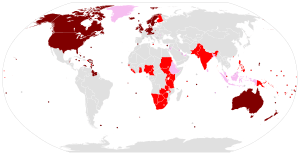Germanic languages facts for kids
Quick facts for kids Germanic |
|
|---|---|
| Teutonic | |
| Geographic distribution: |
Principally northern, western and central Europe, the Americas (Anglo-America, Caribbean Netherlands and Suriname), Southern Africa and Oceania |
| Linguistic classification: | Indo-European
|
| Proto-language: | Proto-Germanic |
| Subdivisions: |
North Germanic
West Germanic
East Germanic (extinct)
|
| ISO 639-2 and 639-5: | gem |
 World map showing countries where a Germanic language is the primary or official language
Countries where (a) Germanic language(s) is/are the first language(s) of the majority of the population Countries or regions where (a) Germanic language(s) is/are (an) official but not primary language(s) Countries or regions where (a) Germanic language(s) is/are (an) unofficial but recognised/used in some areas of life/spoken among a local minority |
|
The Germanic languages are a group of languages that are all related. They are part of a much bigger family called Indo-European languages. All Germanic languages grew from an older language called Proto-Germanic. People first spoke Proto-Germanic in parts of Northern, Western, and Central Europe.
Today, Germanic languages are divided into three main groups. These are the East Germanic languages, the North Germanic languages, and the West Germanic languages. All the East Germanic languages are now extinct, meaning no one speaks them anymore.
Contents
West Germanic Languages
The West Germanic languages are spoken by many people around the world. These languages include:
North Germanic Languages
The North Germanic languages are mainly spoken in Scandinavia and nearby islands. They are sometimes called the Nordic languages. These languages include:
East Germanic Languages
The East Germanic languages are all extinct. This means they are no longer spoken by anyone. Some of these languages include:
- Gothic (we have old texts written in Gothic)
- Vandalic
- Burgundian
- Crimean Gothic
Images for kids
See also
 You can also read about Germanic languages in Spanish: Lenguas germánicas para niños
You can also read about Germanic languages in Spanish: Lenguas germánicas para niños


